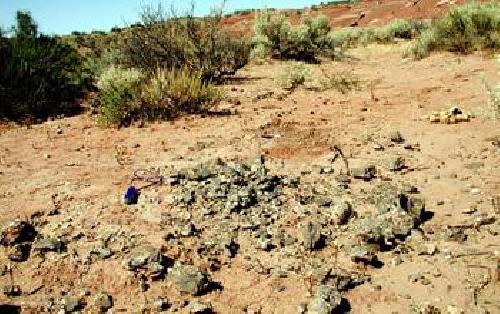Were dinosaurs fast, aggressive hunters like those in the movie "Jurassic World", or did they have lower metabolic rates that made them more like today's alligators and crocodiles?
For 150 years, scientists have debated the nature of dinosaurs' body temperatures and how they influenced activity levels.
A new paper contends that some dinosaurs had the capacity to elevate their body temperatures using heat sources in the environment, such as the sun.

The researchers also believe the animals were probably more active than modern-day alligators and crocodiles, which can be energetic, but only for brief spurts. The evidence shows that some dinosaurs had lower body temperatures than modern birds, their only living relatives, and were probably less active.
Led by Robert Eagle, a researcher at UCLA, the scientists examined fossilized dinosaur eggshells from Argentina and Mongolia. Analyzing the shells' chemistry allowed them to determine the temperatures at which the eggshells formed.
"This technique tells you about the internal body temperature of the female dinosaur when she was ovulating," says Aradhna Tripati, a co-author of the study and a UCLA geologist. "This presents the first direct measurements of theropod body temperatures."
The Argentine eggshells, which are approximately 80 million years old, are from large, long-necked titanosaur sauropods, members of a family that includes the largest animals to roam the Earth--relatives of Brontosaurus and Diplodocus.
The shells from Mongolia's Gobi desert, 71 million to 75 million years old, are from oviraptorid theropods, much smaller dinosaurs that were related to Tyrannosaurus rex and birds.
Sauropods' body temperatures were warm--approximately 100 degrees Fahrenheit. The smaller dinosaurs had substantially lower temperatures, probably below 90 degrees.
Warm-blooded animals, or endotherms, produce heat internally and maintain their body temperatures, regardless of the temperature of their environment; they do so mainly through metabolism. Humans and other mammals fall into this category.
Cold-blooded animals, or ectotherms, including alligators, crocodiles and lizards, rely on external environmental heat sources to regulate their body temperatures. Lizards, for example, often sit on rocks in the sun to absorb heat, which allows them to be active.
Scientists have long debated whether dinosaurs were endotherms or ectotherms. The research indicates that the answer could lie somewhere in between.
"The temperatures we measured suggest that some dinosaurs were not fully endotherms like modern birds," Eagle says. "They may have been intermediate--somewhere between modern alligators and crocodiles, and modern birds. That's the implication for the oviraptorid theropods.
"This could mean that they produced some heat internally and elevated their body temperatures above that of the environment, but didn't maintain as high temperatures or as controlled temperatures as modern birds. If dinosaurs were endothermic to a degree, they had more capacity to run around searching for food than alligators would."
The researchers also analyzed fossil soils, including minerals that formed in the upper layers of soils on which the oviraptorid theropod nests were built. That enabled them to estimate that the environmental temperature in Mongolia shortly before the dinosaurs went extinct was approximately 79 degrees Fahrenheit.
"The oviraptorid dinosaur body temperatures were higher than the environmental temperatures--suggesting they were not truly cold-blooded, but intermediate," Tripati says.
Eagle, Tripati and their colleagues initially looked at modern eggshells from 13 bird species and nine reptiles to establish their ability to determine body temperatures from the chemistry of eggshells.
The researchers measured, in calcium carbonate minerals, the subtle differences in the abundance of chemical bonding between two rare, heavy isotopes: carbon-13 and oxygen-18.
They studied the extent to which these heavy isotopes clustered together using a mass spectrometer--a technique that enabled them to determine mineral formation temperatures. Minerals forming inside colder bodies have more clustering of isotopes.
The scientists analyzed six fossilized eggshells from Argentina, three of which were well-preserved, and 13 eggshells from Mongolia's Gobi Desert, again selecting three that are well-preserved.
The answers offered new insights into dinosaurs' body temperatures--and a long-standing debate.
Source: National Science Foundation




Comments